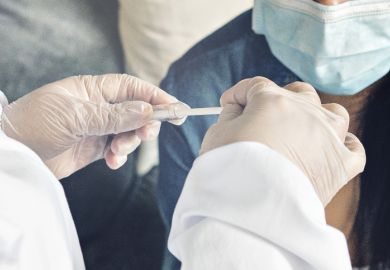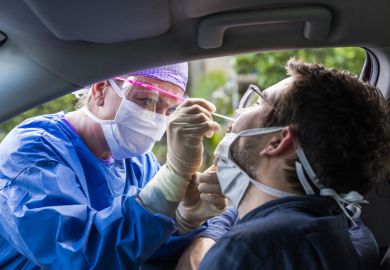Scientists have backed the use of lateral flow testing on students’ return to UK campuses after hailing a pilot project aimed at limiting the spread of Covid-19 as a success.
Speaking at a briefing on the results of the government’s pilots of lateral flow testing of asymptomatic populations in different communities, John Bell, Regius professor of medicine at the University of Oxford and an adviser to the government, said the pilot at Durham University “looks like it worked”.
Durham was the first to pilot the lateral flow testing, which tests how infectious a person is, between 24 November and 16 December. Other institutions in the UK have also used lateral flow testing ahead of the Christmas holidays, following government guidance.
“We’ve learned a huge amount, which is going to make it easier for other universities to pick up this technology,” Professor Bell said. “These are people who never would have been identified before. It’s a big number that have been caught.”
Jacqui Ramagge, executive dean of the Faculty of Science at Durham, said the university was still working on the data from the results, but said the evidence has shown “that our workplace is very, very safe”.
Professor Ramagge said there were a few cases where a lateral flow test came back positive, but their subsequent PCR test, required in accordance with current public health guidelines, had been negative. This meant they had likely unnecessarily self-isolated for a few days. However, as this happened to only 0.29 per cent of those tested, it was “very small price to pay for identifying people who did not know they were infectious and would otherwise have been vectors in the community”, she said.
Durham would be testing students on the first, the fourth and the seventh day of their return to campus in January, Professor Ramagge said, and the university would ask students to minimise contact with the town in their first week.
“We are planning to test students every week, and also more regularly if they wish to take part in any wider student experience,” she said. This would include taking part in sports, theatre or music, though not as a spectator.
The usefulness of weekly or biweekly testing to slow the spread of the virus was backed up by the rest of the panel.
Some students had been forced to go through four successive isolations, and while “that’s very, very patient of them, of course it takes its toll. So we’re very keen to use the LFT to open up the student experience,” Professor Ramagge said.
However, lateral flow testing has come under scrutiny in the past week, after Jon Deeks, professor of biostatistics at the University of Birmingham, tweeted that when the university retested 710 students who had taken the test there had been “six false negatives”. According to Professor Deeks, this meant that the test had only detected 3 per cent of cases.
However, the scientists from Oxford, Durham and the University of Liverpool said these results were “completely inconsistent with all other studies that have been done”.
Professor Bell added that the Birmingham situation was also a very small sample. “The interesting question is: why is it a major outlier?” he said.
Iain Buchan, executive dean at the Institute of Population Health at Liverpool, was involved in the mass testing pilot in the city. He said: “The most important fact is this is a quick test; it is a cheap test; it can be done anywhere; and it’s picking up…two-thirds [of the] most infectious people. It’s a useful public health tool.”
Professor Ramagge agreed. “Obviously there are concerns because no test is perfect…but we are very confident. With repeated testing, the possibility of somebody being positive when they are repeatedly testing negative is very, very low.”
Register to continue
Why register?
- Registration is free and only takes a moment
- Once registered, you can read 3 articles a month
- Sign up for our newsletter
Subscribe
Or subscribe for unlimited access to:
- Unlimited access to news, views, insights & reviews
- Digital editions
- Digital access to THE’s university and college rankings analysis
Already registered or a current subscriber?








